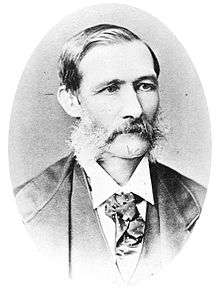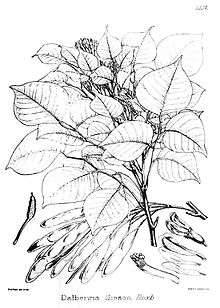Dietrich Brandis
| Sir Dietrich Brandis KCIE, FRS | |
|---|---|
 | |
| Born |
31 March 1824 Bonn |
| Died |
29 May 1907 (aged 83) Bonn |
| Nationality | German |
| Occupation | botanist, forestry academic, civil servant |
Sir Dietrich Brandis, KCIE, FRS (31 March 1824 – 28 May 1907, Bonn) was a German-British botanist and forestry academic and administrator, who worked with the British Imperial Forestry Service in colonial India for nearly 30 years. He joined the British civil service in Burma in 1856, shortly after became head of the British forestry administration in all of Burma, and served as Inspector General of Forests in India from 1864 to 1883. He returned to Europe in 1883, dividing his time between Bonn and Greater London. In retirement he dedicated himself to scholarly work, resulting in his monumental book Indian Trees (1906). He is considered the father of tropical forestry and has also been described as the father of scientific forestry. In addition to his work in India, he also had a significant influence on forestry management in the United States.
Early life, education and family
A member of the patrician Brandis family, Dietrich Brandis was born in Bonn, and was the son of the prominent philosopher Christian August Brandis, who was tutor to the young King Otho of Greece and Professor of Philosophy at the University of Bonn. His grandfather Joachim Dietrich Brandis was personal physician to Queen Marie of Denmark and Norway and a member of the Royal Danish Academy of Sciences and Letters.
He studied at the universities of Copenhagen, Göttingen, Nancy and Bonn. In 1849 he took up a post of a lecturer in botany at Bonn. His interest in forest management was initially from a botanical perspective.
In 1854, he married Rachel Marshman, a sister of the wife of General Havelock, a friend of Lord Dalhousie. It was this connection that brought him to Burma and eventually India.[1] His wife died in India in 1862, and during a two-year sabbatical in Europe 1865–1867 he met and married Katharina Hasse, eighteen years his junior. She moved to India with him and the couple had six children, some of whom did not reach adulthood.[2][3]
Dietrich Brandis was the grandfather of the microbiologist Henning Brandis.
Colonial India
The British government in India was interested in the use of forest produce. The felling of trees was unregulated, and between 1847 and 1850 The British government realized that the forests in India were being lost. In 1850, the British Association in Edinburgh formed a committee to study forest destruction at the behest of Dr. Hugh Cleghorn. In 1855, Lord Dalhousie, the Governor-General of India issued a Memorandum of the Government of India dated 3-8-1855. This was based on reports submitted by John McClelland, then Superintendent of Forests in Burma (then part of the Indian Empire). This was a time when the need for forest management was felt.
Burma
Brandis joined the British civil service in 1856 as superintendent of the teak forests of Pegu division in eastern Burma. In 1858 he became head of the imperial forest administration of all of British Burma.
During that time Burma's teak forests were controlled by militant Karen tribals. He introduced the "taungya" system (King KFS (1968). "Agro-silviculture (the taungya system)". University of Ibadan / Dept. of Forestry, Bulletin no. 1, 109pp.), in which Karen villagers provided labour for clearing, planting and weeding teak plantations. In return they were allowed to plant crops for the first few years between the trees. As the teak trees grew, villagers were moved to new land and the process was repeated. As a result of this process, many villagers became dependent on the state forestry service and local resistance to the state takeover of forests became increasingly difficult.
Brandis was initially interested in botany. His herbarium and botanical library which he shipped from Calcutta to Rangoon were lost when the boat carrying it capsized. This loss led him to shift his focus from botanical studies to forestry.
Brandis' work included determination of teak volume, rate of growth, identifying rate of harvest, developing forest protection plans against pests and fire. He also introduced timber purchase rules, clearing rules and the establishment of managed teak areas called conservancies with officers who were appointed as Conservators.
Contribution to forestry management in India
In 1864 Brandis became Inspector General of Forests in India, a position he served in for 20 years. He formulated new forest legislation and helped establish research and training institutions. The Imperial Forest School at Dehradun was founded by him. Brandis was created a Companion of the Indian Empire in 1878. He became a Knight Commander of the same order in 1887.
Brandis documented the sacred groves in Rajputana and Kans (woodlands) of Mysore, the Garo and Khasia hills which he visited in 1879, the Devarakadus of Coorg in 1868, and the hill ranges of the Salem district in the Madras Presidency in 1882, the Swami Shola on the Yelagiris, the sacred grove at Pudur on the Javadis and several sacred forests on the Shevaroys. He was among the earliest in India to formally link forest protection with local peoples.
He also took an interest in the forest flora of northwest and central India and Indian trees. Even after retirement Brandis continued to work on Indian forestry and at the age of 75 he started his principal botanical work, Indian Trees, dealing with 4400 species. It was first published in 1906 and re-issued several times afterwards, the last time in 1971. He was posted at Balaghat in M.P. as a principal of forester training institute for a long time in his service period.
He introduced scientific forestry in which some trees of given area are cut and timber was planted.
Retirement
After his retirement from the position as Inspector General of Forests in India in 1883, he returned to Bonn, but frequently visited England in the following years. From 1900 until 1906 he lived permanently in Kew in Greater London. Shortly after returning to Bonn in late 1906, he was hospitalized and died few months later.
In retirement, he dedicated much of his time to academic activities, notably resulting in his monumental book, Indian Trees (1906). He also supervised training of forestry students at the Royal Indian Engineering College in England for eight years (1888–1896). His interest in American affairs led him to take special care of American foresters visiting Europe, for which he received a personal letter of thanks by President Theodore Roosevelt in 1904.[4]
Broader influence

Brandis was also involved in forestry education in England at Coopers' Hill. He also influenced and mentored many like Berthold Ribbentrop, W. Schlich and C.A. Schenck of Germany (while a visiting professor at the University of Giessen), and Gifford Pinchot and Henry Graves (the first and second chiefs of the USDA Forest Service) of the United States.
He influenced the forestry movement in the United States by mentoring Pinchot, Graves, and others who came to study with him in Germany, and through his voluminous correspondence with many other men such as Charles Sprague Sargent and Franklin Hough involved in establishing the U.S. national forest system. Pinchot relied heavily upon Brandis' advice for introducing professional forest management in the U.S. and on how to structure the Forest Service when Pinchot established it in 1905. His influence was so great that President Roosevelt, sent him a photograph in 1896 with the inscription
To Sir Dietrich Brandis, in high appreciation of his services to forestry in the United States. From Theodore Roosevelt."[5]
Honours
- Honorary member of the Royal Scottish Arboricultural Society, 1874
- Fellow of the Royal Society, 1875
- Companion of the Order of the Indian Empire, 1878
- Knight Commander of the Order of the Indian Empire, 1887
- The honorary title Professor awarded by the Prussian Minister for Agriculture and Forestry, 1893
- Doctor honoris causa of law, University of Edinburgh, 1898
- Honorary member of the Society of American Foresters, 1904
Legacy
Many species of plants are named after him:
- Dendrocalamus brandisii (Munro) Kurz
- Diospyros brandisiana Kurz
- Ochlandra brandisii Gamble
- Macaranga brandisii King
- Millettia brandisiana Kurz
- Orophea brandisii Hook.f. & Thomson
- Quercus brandisiana Kurz
- Ardisia brandisiana Kurz
- Iodes brandisii Kurz
- Ixora brandisiana Kurz
- Loranthus brandisanus Kurz
- The genus Brandisia Hook.f. & Thomson is also named after him.
Notes
- ↑ Rajan, Ravi (1998). "Imperial environmentalism or environmental imperialism?". In Richard H. Grove, Vinita Damodaran and Satpal Sangwan. Colonial foresters and the agendas of forest management in British India 1800-1900. pp. 324–371.
- ↑
 Prain, David (1912). "Brandis, Dietrich". In Lee, Sidney. Dictionary of National Biography, 1912 supplement. London: Smith, Elder & Co.
Prain, David (1912). "Brandis, Dietrich". In Lee, Sidney. Dictionary of National Biography, 1912 supplement. London: Smith, Elder & Co. - ↑ "Obituary Notices of Fellows deceased. Sir Dietrich Brandis, 1824-1907". Proceedings of the Royal Society Series B. 80: iii–vi. 1908.
- ↑ R.P. Sharma, The Indian Forester, vol. 112, 1986
- ↑ Proceedings of the Royal Society of London: Biological sciences, Volume 80, page V paragraph IV
- ↑ IPNI. Brandis.
References
- (1907) Obituary: Sir Dietrich Brandis, F. R. S. The Geographical Journal 30(1):97.
- Rao, V. S. 1961. 100 years of Indian Forestry. Souvenir. Forest Research Institute. Dehra Dun. scanned version
- Herbert Hesmer. "Leben und Werk von Dietrich Brandis. Begründer der tropischen Forstwirtschaft, Förderer der forstlichen Entwicklung in den U.S.A., Botaniker und Ökologe". Abstracts of the Rheinisch-Westfälische Akademie der Wissenschaften, Vol. 58. XXIII u. 476. Westdeutscher Verlag, Opladen, 1975.
- James G. Lewis. The Forest Service and the Greatest Good: A Centennial History. Durham, NC: Forest History Society, 2005.
- S. S. Negi. Sir Dietrich Brandis: Father of Tropical Forestry. Dehra Dun, India: Bishen Singh Mahendra Pal Singh, 1991.
- Weil, Benjamin, "Conservation, Exploitation, and Cultural Change in the Indian Forest Service, 1875-1927". Environmental History 11.2 (2006): 57 pars. 26 April 2007
- David Prain, rev. M. Rangarajan. "Brandis, Sir Dietrich (1824–1907)". Oxford Dictionary of National Biography (online ed.). Oxford University Press. doi:10.1093/ref:odnb/32045. (Subscription or UK public library membership required.)
External links
| Wikimedia Commons has media related to Illustrations of Forest Flora, 1874. |
- Scanned plates from the Indian forest flora of Dietrich Brandis
- Jan Oosthoek, The colonial origins of scientific forestry in Britain
- http://www.ifs.nic.in